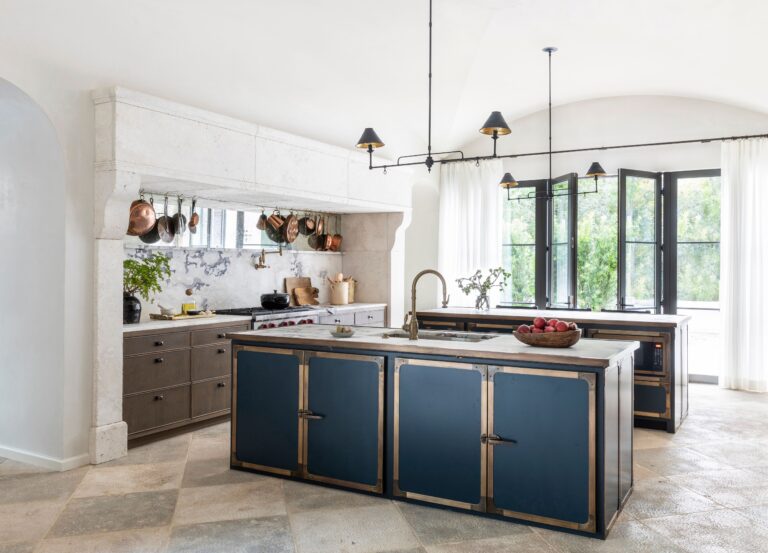Kitchen islands have long been celebrated for providing chefs with essential prep, cooking, plating, and storage space, but in recent years, islands have transcended that original purpose to become the hub of the family—a versatile space where people can eat, scroll, congregate, tackle schoolwork, and even work remotely. everyone You want a seat at the kitchen island. So it's no wonder that this shared necessity ranks high on luxury home buyers' wish lists, according to a recent survey. Islands came in tied for second place, behind double vanities in the bathroom.
This home fixture is so in demand that some homeowners and designers are choosing to install not just one, but two islands. These companion pieces, called double islands, are highly functional, but are they right for your home? Here are some things to consider before installing two in your kitchen.
What is a double kitchen island?
A double kitchen island is a set of islands that are stacked, back to back or side by side. In most cases the sets are the same size but they can vary depending on the amount of space available.
Designated purpose
Typically, each island is designed with a specific function in mind. For example, one island might be designated for food prep, with a sink, wine fridge, and other integrated appliances. Conversely, another island can be used for flipping through magazines, sorting mail, doing homework, or even eating on a bar stool. That means you can drop off groceries or prepare dinner without having to shuffle or remove papers or other household items beforehand.
This sisterly approach means that islands can be designed to maximize the functionality of your kitchen space. Regardless of their purpose, each island has great potential to meet the storage needs that align with the purpose of that particular space. For example, an island designated for eating or working can hold office or school supplies, plates, cups, cutlery, napkins, and more.
Bree Williams
Where does Double Island work best?
“If my clients have a large galley kitchen, I recommend a double island,” says interior designer Jesse DeSanti. Another characteristic of kitchens that are ideal for a double island is one that doesn't allow for a work triangle or cooking triangle (a design concept that seamlessly connects the sink, prep space, and refrigerator to maximize a kitchen's efficiency). If your layout doesn't fit this traditional kitchen design rule, a double island can help create a flow between these major kitchen appliances, DeSanti says.
Make sure you have enough space
DeSanti is increasingly hearing double islands from her clients, but she emphasizes that this isn't possible regardless of the size of the kitchen; bigger is better. “Two islands can divide a large kitchen by filling up floor space and separating separate areas,” she adds. “We dedicate one island with a sink and ample workspace for prep and another for dining with bar stools. Each island needs to be large enough for the layout to feel purposeful and strategic; simply cutting a standard-sized island in half can make the space feel disjointed and choppy.”
Design the rest of the room around the island
Although double islands take up floor space and work best in large rooms, DeSanti uses these factors to her advantage: If a double island is high on a client's wish list, she opts for a second island rather than the upper cabinets. The second island's extra cabinets provide ample storage space, so she can utilize that would-be cabinet space in other ways to make the room more airy and interesting, from a wall of windows to a dramatic backsplash—or both.
Lighting also plays into this delicate balance of kitchen layout design. DeSanti likes to hang two large pendants above each island, making them feel weighted in the space. “Dedicating at least two light fixtures to each island also creates the right balance between the weight of the island on the floor and the lighting above,” she says.
What are the disadvantages of a double island?
Not all kitchens are large enough to accommodate two islands without making the room feel cramped, and having two islands can sometimes take away from the look of a single focal island.
Aesthetically, a double island kitchen may feel more formal and less inviting, and since a single island naturally draws people together, perhaps you can recreate that communal appeal by installing two mating islands?
Double islands take up a lot of space in your kitchen, so if you don't need the additional surface area for kitchen prep or storage, installing a large kitchen table can provide similar work space and gathering functionality as a second island while still allowing for greater long-term flexibility in your layout.
Is Double Island right for you?
““Double islands work best when they satisfy both the function and style of the kitchen,” DeSanti adds. If they can't do both and a client simply wants it because it's the new trend, she said, she'd steer them in a different direction. Think carefully about both of these factors before committing to this big kitchen feature.


